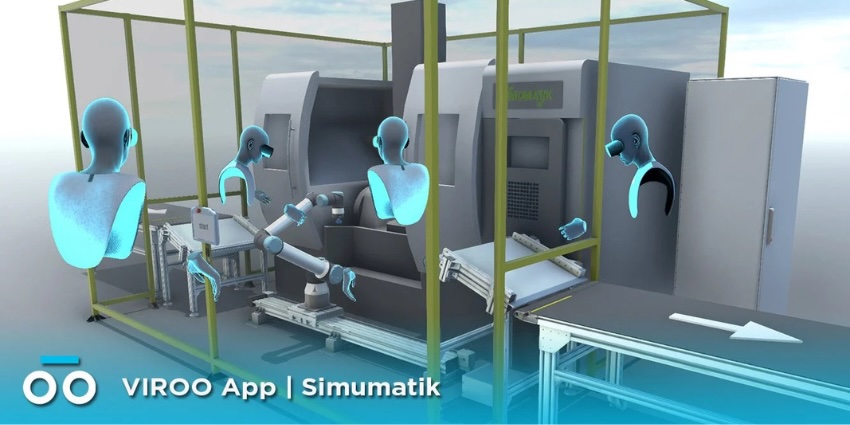Wondering how AI immersive learning benefits your business? You might already be familiar with the incredible impact extended reality can have on training and development.
Studies have shown that XR can improve speed to competence by 52%, reduce training times by 75%, and even strengthen learning retention by 75%. Introducing AI into your development strategy could lead to even better return on investment.
With AI, you don’t have to shell out extra cash for content creation (GenAI can handle the hard work for you). You won’t have to pay for training professionals to join your team members during modules, because everyone will have access to their own live AI coach. You can even save money on scaling your strategy, with systems that automatically update to match new compliance standards.
If you’re worried about creating a business case for AI-powered immersive learning that convinces your stakeholders, here’s how you can calculate the impact of the right technology.
Measuring AI Immersive Learning Benefits: What to Track
If you really want a behind-the-scenes insight into how AI immersive learning benefits your team, and your bottom line, then you’re going to need to look beyond obvious financial results. XR and AI together can save you money on training. Just look at the US Airforce – it saved over $13 million by using immersive training for pilots.
But there are other benefits that are worth measuring too. Look at:
- Time to Competency: How quickly do teams develop new skills? PwC says that VR learners can finish training sessions 4 times faster than their colleagues. Faster training means less downtime for employees, and lower operational costs.
- Knowledge Retention: Studies show most people forget 90% of what they learn within traditional training sessions in a week. AI-powered immersive learning makes modules more impactful, and engaging, boosting knowledge retention and confidence.
- Engagement Levels: The more involved people feel in training, the more they get from it. VR makes training feel real and relevant. That’s why PwC also found that employees were 275% more confident applying what they learned after VR training.
- Cost Savings: Immersive training, particularly with AI, might cost more to implement upfront, but it could save you a fortune in the long term, particularly if you’re using AI to personalize and update training modules at scale.
- Performance Improvements: The better the training experience is, the better your employees will perform. Track their productivity and efficiency levels, how often they apply new skills on the job, and whether error rates drop.
Depending on what you’re using training for, you might track other metrics too. For instance, if you’re using AI-powered simulations to train customer service teams, monitor the changes in your NPS and CSAT scores.
Setting Benchmarks and Managing Rollouts
Before you begin exploring AI immersive learning benefits for yourself, it’s worth pausing to ask yourself how you’re going to know if your strategy works.
Setting benchmarks can help here. Based on what you’re using your AI-powered XR training modules for, list a few things you should be tracking. If you’re using your tools for onboarding and knowledge transfer, take a note of how long these processes usually take today, and how often new hires make mistakes, even after training.
If you’re using your strategy to train teams on technical skills, look at how quickly employees develop those competencies now, and how often you need to update training resources. Figure out how you’re going to measure the results going forward.
You might gather direct feedback from team members with surveys and questionnaires, or use the built-in tools within your platform to monitor things like completion and engagement rates. Your AI and XR training vendors might even give you access to tools that can monitor things like employee sentiment or confidence levels.
When you’re ready to begin testing, remember you don’t have to go all-in straight away. You can begin with a pilot program for a few employees in a high-impact area like customer service. You might even run A/B tests before introducing your new initiative to your whole team.
Making the Most of Analytical Platforms
Feedback taken directly from your employees and insights into AI immersive training completion rates are great for tracking the effectiveness of your strategies. But if you really want to calculate the ROI of AI immersive learning benefits, get creative with how you gather data.
Most XR platforms with built-in AI capabilities will have easy-to-read dashboards and reporting tools. You’ll be able to configure them to track everything from the time team members spend in training to how often they struggle on specific tasks.
Use your AI-powered solutions to dig deeper into valuable insights, such as:
- How learners react to scenarios
- What mistakes do they make (and how often)
- Where they hesitate or disengage
- Whether their skills improve after feedback
Remember to connect your AI-powered XR training platforms to the other tools you use to gather data, too. You should be able to link your solution to LMS systems, HR software, and anything else that can help centralize your data.
Scaling AI Immersive Learning Benefits
Once you’ve actually started to see great results from your AI-powered XR training strategies, the next step is scaling. If you’ve run basic pilot programs already, gathered feedback, and created a few custom reports, you should already have a great “business case” document underway.
Here are a few quick tips for creating a solid case that speaks to your C-Suite:
- Show the Before and After: Use your benchmarks. Show how long it used to take people to learn something, and how much faster they picked it up with immersive training. Show the drop in mistakes, the rise in confidence, the savings in instructor time or travel costs.
- Tell a Story: Data is great, but your employees’ insights are valuable too. Share what employees are saying about their experience. Quote the manager who noticed fewer errors. Highlight how a new hire felt more prepared on day one.
- Simplify Scalability: Draw attention to how easy AI makes it to scale your immersive training strategy. For instance, you might be able to build a single module and customize it with AI to suit countless learners. That saves you time and money.
You can also draw attention to the unique benefits your vendor offers, such as support with creating content or the ability to bring in your own AI models and data.
The Tangible Benefits of AI-Powered Immersive Learning
AI immersive learning benefits businesses in more ways than you might think. It’s not just a great tool for creating contextual, personalized content at scale. AI can help you improve learning outcomes (even more than XR on its own), and drive continuous growth.
The future of workforce development is set to be more immersive, engaging, and intelligent than ever before. Use AI and XR together correctly, and you won’t just cut costs, you’ll build a team that’s always ready for anything.







